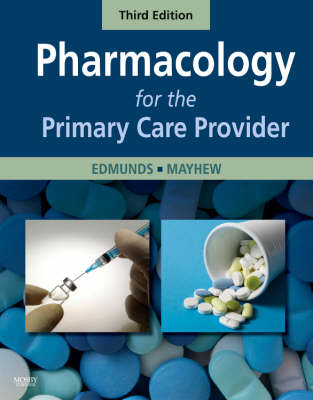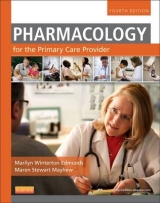
Pharmacology for the Primary Care Provider
Mosby (Verlag)
978-0-323-05131-6 (ISBN)
- Titel erscheint in neuer Auflage
- Artikel merken
Written by and for nurse practitioners, this practical textbook focuses on what primary care providers need to learn and practice drug therapy. With an overall emphasis on patient teaching and health promotion, you will learn how to provide effective patient teaching about medications and how to gain patient compliance. Drug coverage focuses on key drugs rather than prototype drugs, so you can find important information about the most commonly used drugs rather than the first drug in each class. You will also find discussions on the legal and professional issues unique to nurse practitioners and other primary care providers. The 3rd edition also features an expanded emphasis on established clinical practice guidelines and evidence-based practice, plus two new chapters that cover drugs for ADHD and drugs for dementia.
PART ONE - ESSENTIAL CONCEPTS FOR THE PRESCRIPTION OF MEDICATIONS Unit 1: Foundations of Prescriptive Practice 1.Prescriptive Authority and Role Implementation: Tradition vs. Change 2.Historical Review of Prescriptive Authority: The Role of Nurses (NPs, CNMs, CRNAs, and CNSs) and Physician Assistants Unit 2: Pharmacokinetics and Pharmacodynamics 3.General Pharmacokinetic and Pharmacodynamic Principles 4.Special Populations: Geriatrics 5.Special Populations: Pediatrics 6.Special Populations: Pregnant and Nursing Women Unit 3: The Art and Science of Pharmacotherapeutics 7.Establishing the Therapeutic Relationship 8.Practical Tips on Writing Prescriptions 9.Treatment Guidelines and Evidence-Based Decision Making 10.Design and Implementation of Patient Education PART TWO - DRUG MONOGRAPHS Unit 4: Topical Agents 11.Dermatologic Agents 12.Eye, Ear, Throat, and Mouth Agents Unit 5: Respiratory Agents 13.Upper Respiratory Agents 14.Asthma and COPD Medications Unit 6: Cardiovascular Agents 15.Hypertension and Miscellaneous Antihypertensive Medications 16.Coronary Artery Disease and Antianginal Medications 17.Chronic Heart Failure and Digoxin 18.a-Blockers 19.Calcium Channel Blockers 20.ACE Inhibitors and Angiotensin Receptor Blockers 21.Antiarrhythmic Agents 22.Antihyperlipidemic Agents 23.Agents that Act on Blood Unit 7: Gastrointestinal Agents 24.Antacids and the Management of GERD 25.Histamine-2 Blockers and Proton Pump Inhibitors 26.Laxatives 27.Antidiarrheals 28.Antiemetics 29.Medications for Irritable Bowel Syndrome and Other Gastrointestinal Problems Unit 8: Renal/Genitourinary Agents 30.Diuretics 31.Male Genitourinary Agents 32.Agents for Urinary Incontinence and Urinary Analgesia Unit 9: Musculoskeletal Agents 33.Acetaminophen 34.Aspirin and Nonsteroidal Antiinflammatory Medications 35.Disease-Modifying Antirheumatic Medications and Immune Modulators 36.Gout Medications 37.Osteoporosis Treatment 38.Muscle Relaxants Unit 10: Central Nervous System Agents 39.Overview of the Nervous System 40.Medications for Attention-Deficit/Hyperactivity Disorder 41.Medications for Dementia 42.Analgesia and Pain Management 43.Migraine Medications 44.Anticonvulsants 45.Antiparkinson Agents Unit 11: Psychotropic Agents 46.Antidepressants 47.Antianxiety and Insomnia Agents 48.Antipsychotics 49.Substance Abuse Unit 12: Endocrine Agents 50.Glucocorticoids 51.Thyroid Medications 52.Diabetes Mellitus Agents Unit 13: Female Reproductive System Medications 53.Contraceptives 54.Menopause Hormone Therapy 55.Agents Used in Treating Breast Cancer Unit 14: Antiinfectives 56.Principles for Prescribing Antiinfectives 57.Treatment of Specific Infections and Miscellaneous Antibiotics 58.Penicillins 59.Cephalosporins 60.Tetracyclines 61.Macrolides 62.Fluoroquinolones 63.Aminoglycosides 64.Sulfonamides 65.Antitubercular Agents 66.Antifungals 67.The Immune System and Antiretroviral Medications 68.Antiviral and Antiprotozoal Agents Unit 15: Health Promotion 69.Immunizations and Biologicals 70.Weight Management 71.Smoking Cessation 72.Vitamins and Minerals 73.Over-the-Counter Medications 74.Complementary and Alternative Therapies Appendix Economic Foundations of Prescriptive Authority
| Zusatzinfo | Approx. 100 illustrations |
|---|---|
| Verlagsort | St Louis |
| Sprache | englisch |
| Maße | 216 x 276 mm |
| Themenwelt | Medizin / Pharmazie ► Medizinische Fachgebiete ► Pharmakologie / Pharmakotherapie |
| ISBN-10 | 0-323-05131-6 / 0323051316 |
| ISBN-13 | 978-0-323-05131-6 / 9780323051316 |
| Zustand | Neuware |
| Haben Sie eine Frage zum Produkt? |
aus dem Bereich



